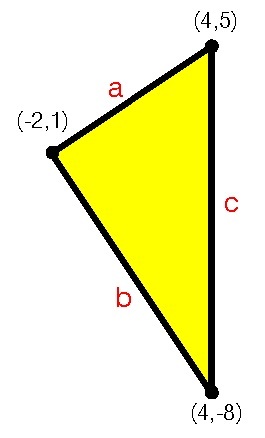Pythagorean Theorem
The three vertices of a triangle are (4,5), (-2,1), and (4,-8). Is this a right triangle?
This section requires Javascript.
You are seeing this because something didn't load right. We suggest you, (a) try
refreshing the page, (b) enabling javascript if it is disabled on your browser and,
finally, (c)
loading the
non-javascript version of this page
. We're sorry about the hassle.
2 solutions

Solving for the distances using the formula, d = ( x 2 − x 1 ) 2 + ( y 2 − y 1 ) 2 ,
a = ( 4 + 2 ) 2 + ( 5 − 1 ) 2 = 5 2
b = ( 4 + 2 ) 2 + ( − 8 − 1 ) 2 = 1 1 7
c = ( 4 − 4 ) 2 + ( − 8 − 5 ) 2 = 1 3
Now by Pythagorean theorem, check if it is a right triangle
a 2 + b 2 = c 2
( 5 2 ) 2 + ( 1 1 7 ) 2 = 1 3 2
5 2 + 1 1 7 = 1 6 9
1 6 9 = 1 6 9 ⟹ t r u e
∴ I t i s a r i g h t t r i a n g l e .
a = [ ( 4 − ( − 2 ) ] 2 + ( 5 − 1 ) 2 = 6 2 + 4 2 = 3 6 + 1 6 = 5 2 = 4 × 1 3 = 2 1 3
b = [ 1 − ( − 8 ) ] 2 + ( − 2 − 4 ) 2 = 9 2 + 6 2 = 8 1 + 3 6 = 1 1 7 = 9 × 1 3 = 3 1 3
c = ( 4 − 4 ) 2 + [ ( 5 − ( − 8 ) ] 2 = 1 3 2 = 1 3
By the pythagorean theorem , we have
c 2 = a 2 + b 2
1 3 2 = ( 2 1 3 ) 2 + ( 3 1 3 ) 2
1 6 9 = 4 ( 1 3 ) + 9 ( 1 3
1 6 9 = 5 2 + 1 1 7
1 6 9 = 1 6 9 ⟹ The statement is true.
W e t h e r e f o r e c o n c l u d e t h a t t h e p o i n t s ( 4 , 5 ) , ( − 2 , 1 ) a n d ( 4 , − 8 ) a r e v e r t i c e s o f a r i g h t t r i a n g l e .